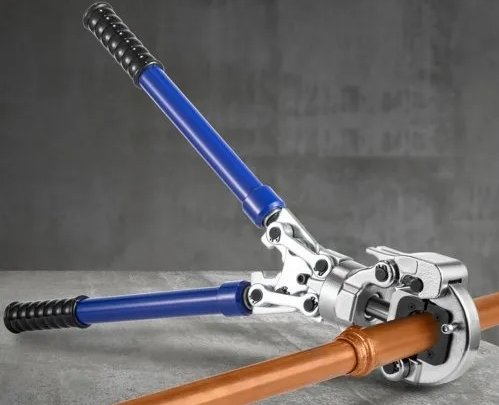In the field of copper tube installation, crimping technology has completely replaced traditional welding as the industry standard—no open flames, no toxic fumes, and speeds increased by more than five times. The key to achieving perfect crimping lies in selecting truly reliable intelligent tools. This article will delve into how the SUMA-1632AF crimping pliers utilize revolutionary pressure control technology to address the top ten pain points of traditional crimping, ushering in an era of “zero leakage” copper tube connections.
Core Principle of Copper Tube Crimp Connections: Triple Sealing Mechanics
Crimping is not merely “compression” but a precise mechanical engineering process:
Mechanical Locking Layer: The copper sleeve ring undergoes controlled deformation, generating a sustained clamping force of 8,000 N
Dynamic Sealing Layer: EPDM rubber O-rings expand under pressure to fill microscopic gaps
Metal Memory Layer: Copper tubes and fittings achieve atomic-level bonding (cold welding effect)
Traditional welding relies solely on solder filling, while crimping’s composite sealing structure better accommodates thermal expansion and contraction
The Golden Eight-Step Method for Copper Tube Crimping
Step 1: Cut and Deburr
Tube end burr height ≤ 0.1mm (scrape with white paper to ensure no threads remain)
Step 2: Mark depth
Draw a circular mark along the pipe wall (distance from the end: 1/2“ pipe = 13mm; 1” pipe = 17mm)
Step 3: Assembly verification
After freely combining the fitting and sleeve ring, insertion depth exceeding the mark by 2mm is considered合格
Step 4: Jaw Selection
Select the pipe diameter (e.g., “3/4”), and the magnetic module automatically attaches and positions
Step 5: 3D Alignment
The jaw and pipe fitting maintain coaxiality ≤ 0.5°
Step 6: Trigger Crimping
Press until closed and hear a “click” sound
Step 7: Quality Double Check
Visual inspection: The indentation depth of the sleeve is uniform (1.2 ± 0.1mm)
Gauge inspection: Passes the GO end / stops at the NO-GO end
Step 8: System reset
Release the pipe fitting and prepare for the next crimping operation
Revolutionary significance for the industry
The SUMA-1632AF upgrades copper tube crimping from “craftsmanship” to “precision engineering,” solving a long-standing industry challenge:
New apprentices’ crimping pass rate increased from 57% to 100%
Engineering rework rate decreased by 90%
Overall construction costs reduced by 40%
Final advice: Always verify with GO/NO-GO gauges—even smart tools require human verification!


